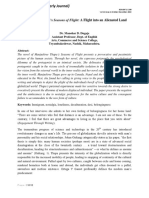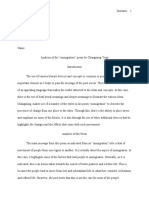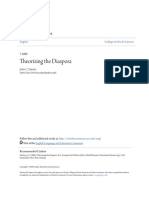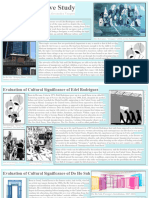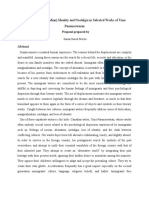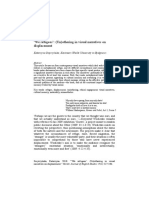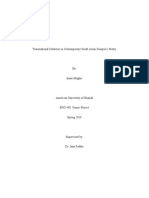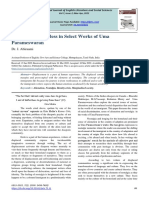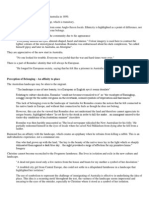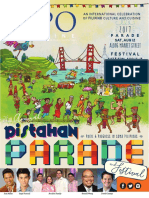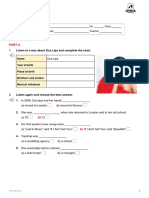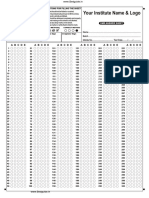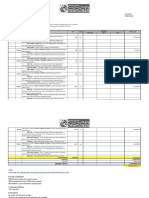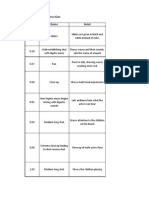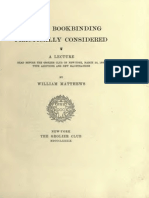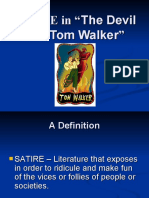Script
Good morning, this is my individual oral IBDP English A language and literature SL, and
the global issue in discussion is To what extent transnational movement precipitates
cultural loss and reshapes personal and communal identities and the field of
inquiry is (Culture, Identity, and Community). This global issue has a lot of significance
as it talks about the negative impact of transnational movement on identity and culture
and how people move from one place to another whether for economic opportunity,
safety or family reunification.
In this Individual oral the literary extract and literary work that i have chosen are
references from ‘Imitation’ from The Thing Around Your Neck by Adichie. The non
literary extract is a collage by Ugur Gallenkus and the BOW is “Migrant Child” mural by
Banksy. I have chosen ‘Imitation’ as it talks about a woman immigrant who has migrated
to the USA to her husband and the problems faced by her and Ugur Gallankus' collages
and Banksy’s murals as they discuss a social impact. In this IO we are going to discuss
the global issue affecting millions in the world that is the impact of dislocation.
Additionally,
This literary extract explores Nkem’s migration journey, using literary devices and
rhetorical appeals to explain the global issue of the impact of migration on identity,
belonging, and cultural dislocation. Through her story, the author reveals how migration
often leads to the feeling of fragmentation and displacement.
The house Nkem and Obiora rent, smelling “fresh, like green tea,” is rich with imagery,
symbolizing a new start, while the “thick gravel driveway” suggests the uneven path of
adaptation. This contrast emphasizes the challenges Nkem faces. Her pride in her new
life is evident when she sends pictures of herself near the Liberty Bell to friends in
Lagos, scribbling “very important in American history” on the back. This act appeals to
ethos, as she seeks to validate her place in a foreign land, but it also reveals her
internal conflict—her desire to succeed in America while holding onto her Nigerian
identity.
The Benin mask and Nok terra-cotta, described as “cold, heavy, lifeless,” become
powerful symbols of cultural dislocation. For Nkem, these artifacts feel distant. Yet,
Obiora’s stories about them—how the British stole them during colonial rule, calling their
actions an “expedition” or “pacification”—add layers of irony. These euphemisms show
the violence of cultural erasure. Similarly, Nkem’s neighbors’ polite curiosity—“Where
was her husband? Was something wrong?”—reveals their inability to understand her
life, highlighting the cultural divide.
�While her neighbors’ children refuse to eat food that has fallen on the ground, calling it
“spoiled,” Nkem recalls her childhood, where “you snatched the food up, whatever it
was, and ate it.” This contrast appeals to pathos, evoking empathy for Nkem’s struggle
to reconcile her values with those of her new community. The act of eating becomes a
metaphor for the choices migrants must make—what parts of their identity to preserve
and what to discard.
The neighbors’ “plastic” lives, as Obiora calls them, represent the homogenized
culture Nkem is expected to adopt. Their curiosity about her life is met with Obiora’s
laughter: “If you did something in a different way, they would think you were abnormal,
as though their way was the only possible way.” This irony underscores the cultural
difference Nkem faces.
This extract uses symbolism, irony, imagery, and metaphor, alongside rhetorical
appeals, to explore the impact of migration on identity and belonging. Nkem’s story
reflects the broader global issue of cultural dislocation, where migrants are caught
between two worlds. Her journey is an important reminder that migration is not just a
physical relocation but a renegotiation of self and community.
Moreover,
Nkem’s move to America is filled with loneliness and longing. "She had not known that
loneliness could feel so heavy," she thinks, using metaphor to show how her sadness
weighs her down. The house she lives in, meant to be a dream home, feels cold and
empty. "The house felt too big, too quiet, too empty," she says, using repetition to
emphasize how lost she feels in this new place.
She misses her old life in Lagos deeply. "She missed the noise of Lagos, the way it
wrapped around her like a blanket," she reflects, using a simile to compare the
comforting chaos of home to a warm, familiar blanket. This contrast highlights how out
of place she feels in America.
As time passes, Nkem begins to wonder if she will ever fit in. "She wondered if she
would ever stop feeling like a stranger," she asks herself, using rhetorical questioning to
show her uncertainty about belonging. This question shows the ongoing struggle many
migrants face—caught between two worlds, never fully at home in either.
Through these quotes, Adichie uses imagery, metaphor, and simile to paint a vivid
picture of Nkem’s journey. Her story is a powerful reminder of the emotional and cultural
�challenges of migration, where identity is often fractured, and belonging feels just out of
reach.
Furthermore,
For my non-literary extract, I have chosen this powerful collage by Ugur Gallenkuş, who
is known for using side-by-side images to show social issues juxtaposes two contrasting
images that highlight the global issue of how transnational movement leads to
cultural loss and changes people’s personal and community identities.
Ugur Gallenkus uses stark visual juxtaposition by showing a contrast between these
images where in the left part of the image, we see a father carrying his child on his
shoulders while walking through a river, surrounded by other people—these are Haitian
immigrants crossing the Rio Grande river this act symbolizes their struggle, care for
family, and hard journey to migrate from one place to another, while in the right part we
see a smiling family enjoying time in a bright and clean garden, this symbolizes the
comfort and privilege of their life. This contrast shows two completely different
lives—while one group is fighting for safety and survival, the other is enjoying peace
and stability. While one group is fighting for safety and survival, the other is enjoying
peace and stability. Also, there is a contrast in the clothes that both are wearing, the
immigrants are wearing old, torn, and dirty clothes that symbolizes poverty and lack of
basic resources like while the family is wearing new and clean clothes that symbolizes
a good lifestyle with all basic resources
The color and tone are also very different. On the left, the colors are darker and the
tone is warm and dull . On the right, the color is brighter and more cool and peaceful.
This helps us clearly feel the emotional difference between the two sides and also how
one is deprived of basic resources which forces them to migrate in search of work and
face a lot of hardship while the other is living a cheerful life and is enjoying all the basic
resources. The diagonal line that is cutting through the father’s body highlights the
difference in their lives. Also the artist has used a closeup shot that emphasizes his in
depth focus on the issue. In the frame both the images are in equal proportion and the
artist has also used fill in the frame showing that migrants' experience is as important
as urban life.
This collage through juxtaposition, contrasting color and tone, symbolism, and
photographic techniques shows how migration caused due to lack of resources leads to
loss of personal and community identities and culture. It depicts how hard the life of
�people who migrate in search of work is, when compared to people living peaceful lives
in urban areas.
Furthermore,
My non-literary body of work is also a collage by the artist Uğur Gallenkuş. In this
image, on the left, we see Palestinian children waiting in line with colorful jerrycans to
collect water from public taps at the Dair Al Balah refugee camp in central Gaza Strip in
2014. On the right, we see children lined up neatly to board a yellow school bus outside
a well-kept brick building in what looks like a developed country.
Here, there is a strong contrast between the two scenes. The orderly school
environment symbolizes education, stability, and support, while the refugee camp
scene with children carrying water shows displacement, scarcity, and the struggle for
basic needs. This creates a shocking juxtaposition between those who have the
resources to support their growth and those who are forced to fight for essentials like
clean water. The image highlights how migration and displacement change everyday
experiences, where education and normal childhood activities are replaced by survival
tasks and adult responsibilities. The brick building symbolizes security and
permanence, while the makeshift refugee camp symbolizes instability and
temporariness, showing how forced migration disrupts normal childhood development.
The composition has a diagonal split acts as a visual metaphor, emphasizing the
difference between privilege and hardship, and the impact of migration on children’s
lives. Also there is a color contrast between the muted, dusty colors of the refugee
camp and the bright, vibrant colors of the school bus and children’s clothing. The artist
has used a wide shot to show the complete reality of both the lives. The children’s body
language is telling—the child in the refugee camp looks burdened and focused on
survival, while the children waiting for the bus appear relaxed and focused on self
development. This contrast in posture further emphasizes their differing realities.
Overall, this collage effectively uses photographic techniques to illustrate the global
issue of how forced migration leads to cultural loss and reshapes identities. It shows
how displacement disrupts educational opportunities and can lead to loss of childhood
itself. The Palestinian children, part of a long-standing refugee situation, represent how
migration creates new identities shaped by scarcity and survival.

